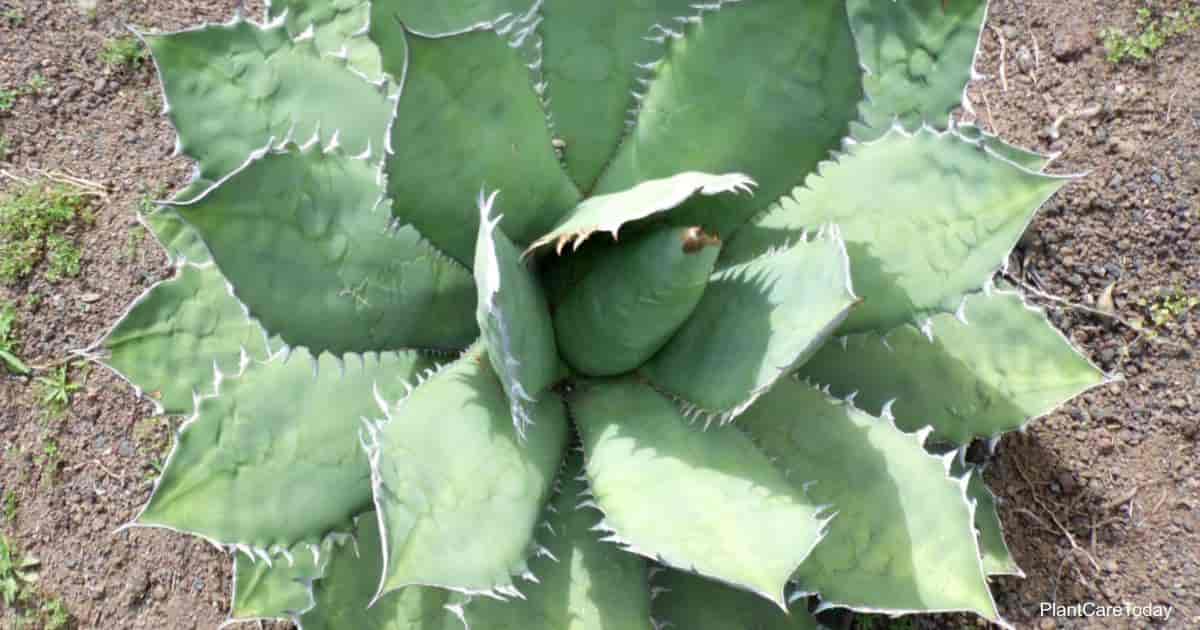Agave titanota [a-GAH-vee, ty-tan-OH-tuh] is an extremely drought-tolerant native of Rancho Tambor, Oaxaca, Mexico, and a perennial member of the Agavaceae family (Agave plants). You may hear this plant by its common name, including:
- Rancho Tambor Agave
- Chalk Agave
- Maguey Cachitun

Agave Titanota Care
Size & Growth
Slow-growing Rancho Tambor agave grows as a solitary rosette form with a maximum height of 1′ – 2′ feet and a width of 2′ – 3′ feet.
The light-colored green leaves of these compact succulents are one to 2′ feet long and about 5″ inches wide.
The leaf margins and tips are tan, and the terminal thorns are interestingly flat.
Although they look sharp, they are not especially hazardous to be around.
Select Species Of Oaxaca Mexico Agave Plants
- Agave titanota ‘White Ice’
- Agave titanota ‘Filigree‘
- Agave titanota ‘Solar Eclipse’
Flowering & Fragrance
The blossoms are yellow and occur very seldom.
When they do appear, you must prepare for the end of your agave, as this is a monocarpic plant that dies after blooming.
Light & Temperature
These hardy, sun-loving succulents can tolerate temperatures as low as 20° degrees Fahrenheit (-7° C).
It also has extremely high heat tolerance.
Although the plant prefers full sun, it can do well in light to partial shade.
Titanota is winter hardy in USDA hardiness zones 9a through 11.
Watering & Feeding
This drought-tolerant desert denizen appreciates deep, occasional irrigation during the hot summer months.
Fresh soil at repotting time will provide nutrients during the first growing season.
At the beginning of the plant’s second growing season in the same pot and soil, top dress the soil with worm castings.
If there is little or no space on the soil’s surface, water the plant deeply at the start of the growing season with a half dose of cactus or succulent fertilizer or with a worm or compost tea.
Soil & Transplanting
This desert dweller can tolerate soil pH levels ranging from 6.1 to 7.8.
Like most cacti and succulents, it prefers coarse, sharply draining soil.
Because these are very slow-growing plants, you will probably not need to repot annually.
This is a good thing because titanota does not like to be handled or disturbed.
Every couple of years, repot the plant when the soil is completely dry.
Brush all the dry soil off the roots and attend to any trimming or maintenance needed at this time.
Repotting in all-new soil gives the plant fresh nourishment.
Grooming & Maintenance
If you wish to collect seeds from your plant, allow the flowers to go to seed after blooming.
Otherwise, remove the spent blossoms and flower stalk when the flowers wither.
How To Propagate Rancho Tambor Agave
This agave grows well from seeds collected from the flowers or order them online.
Alternately, watch for occasional offshoots, which you remove and transplant into their pots or other settings.
Furthermore, you may propagate by division when you transplant or repot the plant.
Rancho Tambor Agave Pest or Diseases
Agaves of all sorts are subject to damage caused by extreme weather.
Additionally, those kept in poorly draining soil or settings with insufficient sun and air circulation are prone to fungal and bacterial infections.
More on Agave Root Rot and How To Treat it here.
Compromised plants are more likely to be invaded by pests, such as scale insects and agave snout weevils.
Is The Agave Toxic or Poisonous?
The sap of this agave may be irritating to sensitive skin.
Even though the tips of the thorns are not especially sharp, they should be respected.
Handle this plant with care when repotting and transplanting.
Is The Agave Invasive?
This slow-growing native plant has very specific environmental requirements.
For this reason, it cannot be considered invasive.
In any setting outside of its natural habitat, it will need to have its specific needs met and will not be able to spread and ramble freely.
Suggested Agave Titanota Uses
Agave titanota can do well as a houseplant or in the landscape in temperate climates, subtropical or Mediterranean climates, and especially in desert garden settings.
It is excellent in addition to desert gardens, a rock gardens, or other xeriscape arrangements with lots of sun.
Because it stays rather small, it’s also good as a container plant or specimen plant for small gardens, balconies, or patio settings.